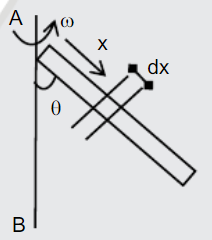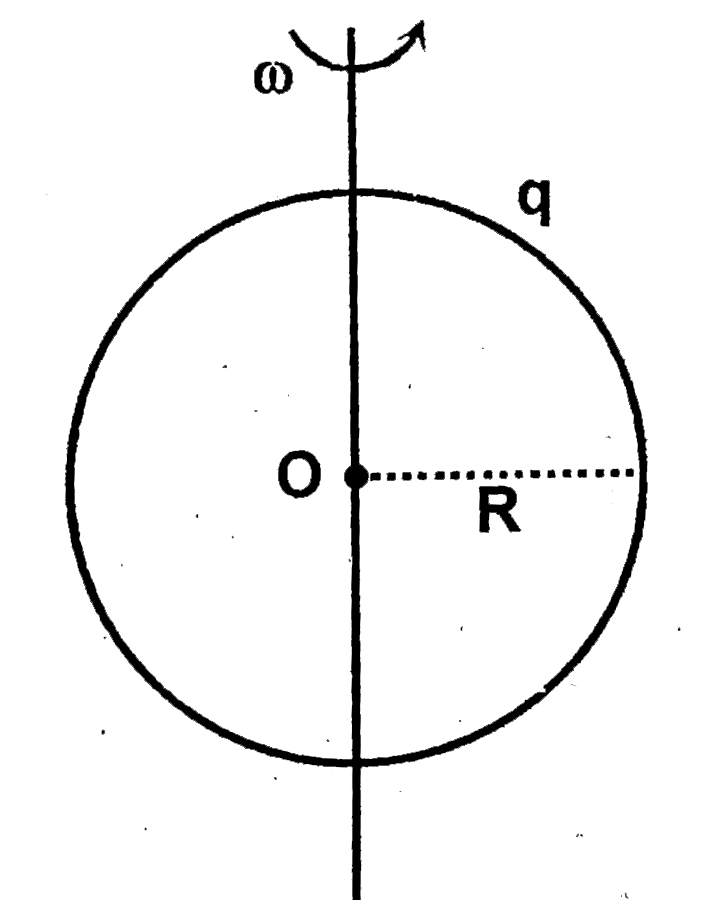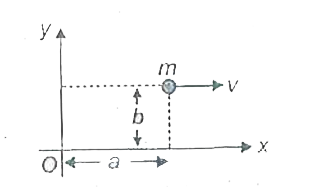A solid sphere is rotating with a constant angular velocity about an axis touching the surface. Its angular momentum will be:
23MR2ω
57MR2ω
75MR2ω
52MR2ω
The correct Answer is:C
To solve the problem of finding the angular momentum of a solid sphere rotating about an axis touching its surface, we can follow these steps:
Step 1: Understand the Problem
We have a solid sphere rotating with a constant angular velocity about an axis that touches its surface. We need to determine its angular momentum.
Step 2: Identify the Moment of Inertia
The moment of inertia (I) of a solid sphere about an axis through its center of mass is given by the formula:
Icm=25mr2
where m is the mass of the sphere and r is its radius.
Step 3: Apply the Parallel Axis Theorem
Since the axis of rotation is not through the center of mass but is touching the surface of the sphere, we will use the Parallel Axis Theorem to find the moment of inertia about the new axis. The theorem states:
I′=Icm+md2
where d is the distance from the center of mass to the new axis. In this case, d=r (the radius of the sphere).
Step 4: Calculate the Moment of Inertia about the New Axis
Substituting the values into the equation:
I′=Icm+mr2
I′=25mr2+mr2
I′=25mr2+55mr2
I′=75mr2
Step 5: Calculate Angular Momentum
The angular momentum (L) is given by the formula:
L=I⋅ω
where ω is the angular velocity. Substituting the moment of inertia we found:
L=(75mr2)⋅ω
Step 6: Final Expression for Angular Momentum
Thus, the angular momentum of the solid sphere is:
L=75mr2ω
Conclusion
The angular momentum of the solid sphere rotating about an axis touching its surface is given by:
L=75mr2ω
We have a solid sphere rotating with a constant angular velocity about an axis that touches its surface. We need to determine its angular momentum.
The moment of inertia (I) of a solid sphere about an axis through its center of mass is given by the formula:
Icm=25mr2
where m is the mass of the sphere and r is its radius.
Since the axis of rotation is not through the center of mass but is touching the surface of the sphere, we will use the Parallel Axis Theorem to find the moment of inertia about the new axis. The theorem states:
I′=Icm+md2
where d is the distance from the center of mass to the new axis. In this case, d=r (the radius of the sphere).
Substituting the values into the equation:
I′=Icm+mr2
I′=25mr2+mr2
I′=25mr2+55mr2
I′=75mr2
The angular momentum (L) is given by the formula:
L=I⋅ω
where ω is the angular velocity. Substituting the moment of inertia we found:
L=(75mr2)⋅ω
Thus, the angular momentum of the solid sphere is:
L=75mr2ω
The angular momentum of the solid sphere rotating about an axis touching its surface is given by:
L=75mr2ω
Topper's Solved these Questions
- SYSTEM OF PARTICLES AND ROTATIONAL MOTIONBOOK - VMC MODULES ENGLISHCHAPTER - SYSTEM OF PARTICLES AND ROTATIONAL MOTIONEXERCISE - ENABLE
50 Videos
- SYSTEM OF PARTICLES AND ROTATIONAL MOTIONBOOK - VMC MODULES ENGLISHCHAPTER - SYSTEM OF PARTICLES AND ROTATIONAL MOTIONEXERCISE - EFFICIENT
50 Videos
- SYSTEM OF A PARTICLES & ROTATIONAL MOTIONBOOK - VMC MODULES ENGLISHCHAPTER - SYSTEM OF A PARTICLES & ROTATIONAL MOTIONEXERCISE - IN-CHAPTER EXERCISE F
10 Videos
- UNITS, MEASUREMENTS & ERRORSBOOK - VMC MODULES ENGLISHCHAPTER - UNITS, MEASUREMENTS & ERRORSEXERCISE - IN - CHAPTER EXERCISE - B
10 Videos
Similar Questions
A rod is rotating with angular velocity ω about axis AB. Find cosθ.

View SolutionA hollow non conducting sphere of radius R has a positive charge q uniformly distributed on its surface. The sphere starts rotating with a constant angular velocity 'ω' about an axis passing through center of sphere, as shown in the figure. Then the net magnetic field at center of the sphere is

View Solution
Knowledge Check
A mass M moving with a constant velocity parallel to the X-axis. Its angular momentum with respect to the origin
Aa. is zeroBb. remains constantCc. goes on increasingDd. goes on decreasing
A particle attached to a string is rotating with a constant angular velocity and its angular momentum is L. If the string is halved and angular velocity is kept constant, the angular momentum will be
View SolutionA particle of mass m is moving with constant velocity v parallel to the x-axis as shown in the figure. Its angular momentum about origin O is

View SolutionA mass m is moving with a constant velocity along a line parallel to the x-axis, away from the origin. Its angular momentum with respect to the origin.
View SolutionA particle moves with a constant velocity parallel to the X-axis. Its angular momentum with respect to the origin
View SolutionA satellite of mass m is circulating around the earth with constant angular velocity. If the radius is R0 and mass of earth is M, then the angular momentum about the centre of the earth is
View SolutionA solid sphere is rotating about a diameter at an angular velocity ω. If it cools so that its radius reduces to 1/n of its original value, its angular velocity becomes
View SolutionA mass is whirled in a circular path with a constant angular velocity and its angular momentum is L. If the string is now halved keeping the angular velocity same, the angular momentum is
View Solution
